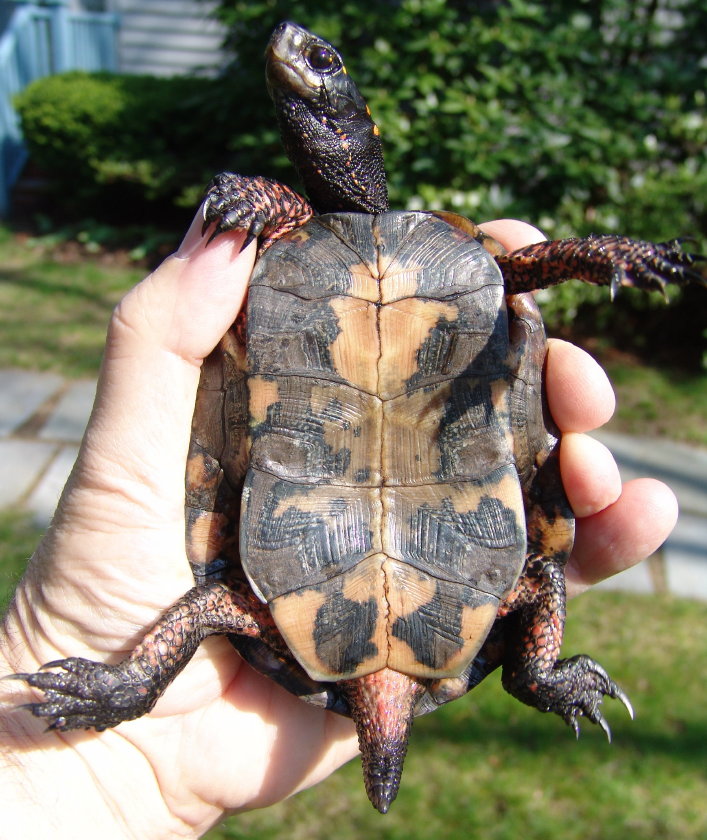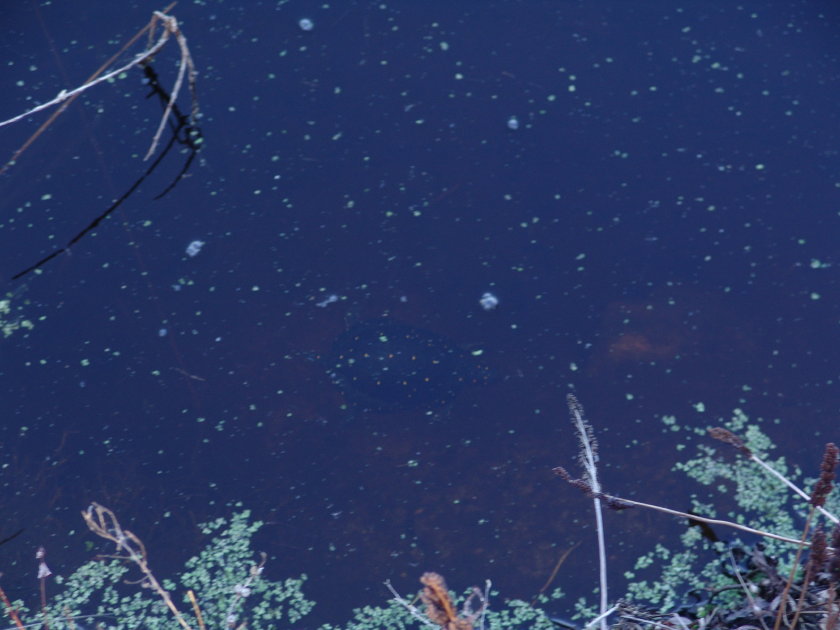Mature Female Spotted Turtle (Clemmys guttata)
Every day brings a fresh surprise to Turtle Journal. As we write this post tonight the thermometer has plunged to one degree above freezing. This morning pegged a little higher at 41 and nudged ever so slightly upward during the day under clear skies and hefty northerly winds. Since we figured critters would be scarce, we shot some distant photos of Bird Island this afternoon in preparation for a future kayak trip when winds subside.
Brainard Marsh, Sippican Lands Trust
On the way back to the office, we stopped at Brainard Marsh, a 6.1-acre conservation area under Sippican Lands Trust. We’ve been monitoring the spotted turtles in a small pond in the middle of the property for the last few years. With cold winds and chilly temperatures, we didn’t expect to find anything, but the area is quietly beautiful on an autumn afternoon.
Female Spotted Turtle; Notice the Anomalous Bump
Crunching over fallen oak leaves and wind-snapped twigs, we approached the pond as stealthy as the Keystone Kops. At the edge of a moss covered bank, we spied a small, seemingly immobile rock with yellow dots about 25 feet ahead through thick bramble. Even though we toe-danced forward, our crackles should have aroused a brumating turtle. Yet we reached the still immobile “rock” that was cold to the touch and discovered a mature female spotted turtle, fully tucked in and apparently sound asleep. She must have crawled up the bank to bask in the noon day sun, only to fall into chilly shadow by mid-afternoon.
Female Spotted Turtle on the Move
In bright sunshine she warmed up and stretched her legs. This turtle sports quite a bump on her carapace (top shell), left of the 4th right costal. You may notice that she also has a number of shell abrasions and an unusual number of vertebral scutes (8) running down the center of her carapace.
Female Spotted Turtle; Note Colorful Neck, Flat Plastron, Thin Tail
She could easily be identified as female based on gender dichromatism in this species. Females have bright colored necks (orange or yellow), while males are darkly colored (brown). Females also have a flat plastron (bottom shell), while males have an abdominal cavity in the center of the plastron. Finally, females have a slender tail, while males have thick tail.
Male Spotted Turtle; Note Dark Neck, Plastron Concavity, Thick Tail
The image above is a typical male spotted turtle for comparison with dark colored neck, plastron concavity and thick tail.
Female Spotted Turtle Carapace (Top Shell)
A close-up of her carapace (top shell) shows the eight vertebral scutes down the center, as well as her yellow spots. While they may seem ornate out of context, when she is within her element, the randomly spaced dots blend perfectly with background pond flotsam floating across the surface of the water. For those who feel particularly sharp-eyed and skilled at turtling, you may enjoy the test below. Find Waldo; that is, locate the spotted turtle in the photograph.
Where’s Waldo?
Yes, Virginia, there is a spotted turtle in the picture.
Tags: Bird Island, brainard marsh, brumating turtle, carapace, clemmys guttata, flotsam, gender dichromatism, Keystone Kops, plastron, Sippican Lands Trust, species, Spotted Turtle, Turtle Journal, vertebral scutes







Thank you Don & Sue, These are fantastic photos!! I forwarded your article to our 14 yr. old grandson in Maine. Grateful for your enthusiasm! Best wishes, Liz